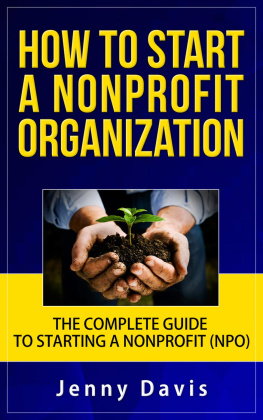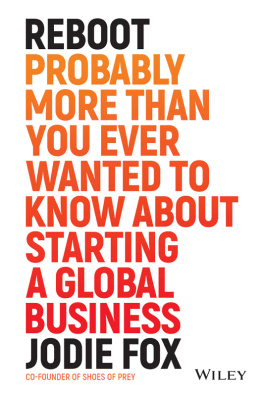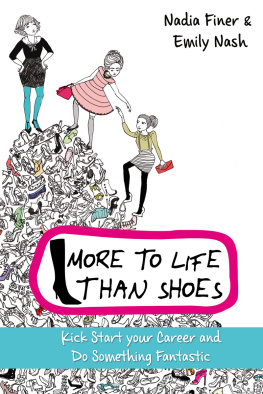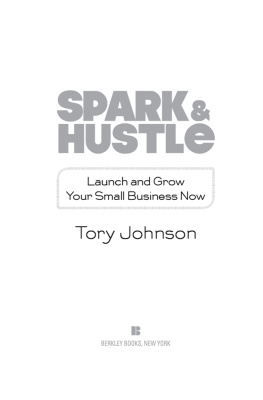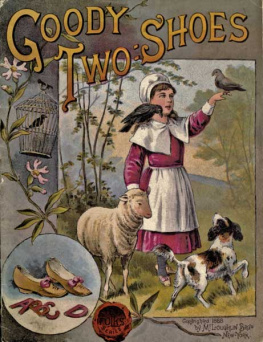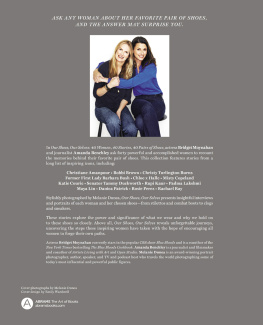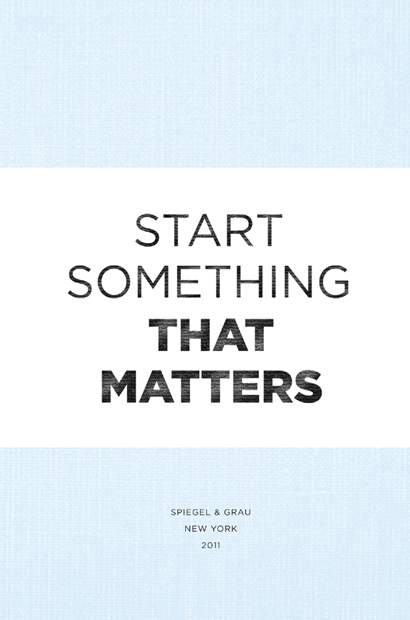
As of press time, the URLs displayed in this book link or refer to existing websites on the Internet. Random House, Inc., is not responsible for, and should not be deemed to endorse or recommend, any website other than its own or any content available on the Internet (including without limitation at any website, blog page, information page) that is not created by Random House.
Copyright 2011 by Blake Mycoskie
Reading group guide copyright 2012 by Random House, Inc.
All rights reserved.
Published in the United States by Spiegel & Grau,
an imprint of The Random House Publishing Group,
a division of Random House, Inc., New York.
S PIEGEL & G RAU and Design is a trademark of Random House, Inc.
The photo on is courtesy of Lauren Garceau.
The photo on is courtesy of Chelsea Diane Photography.
All other photos are courtesy of the author.
Library of Congress Cataloging-in-Publication Data
Mycoskie, Blake.
Start something that matters / Blake Mycoskie.
p. cm.
eISBN: 978-0-679-60352-8
1. MarketingSocial aspects. 2. Social entrepreneurship. I. Title.
HF5414.M93 2011
658.408dc22 2011009768
www.spiegelandgrau.com
Jacket design: Greg Mollica
Jacket photographs: Kwaku Alston
v3.1
SUCCESS
To laugh often and love much
To win the respect of intelligent people
and the affection of children
To earn the appreciation of honest critics
endure the betrayal of false friends
To appreciate beauty
To find the best in others
To leave the world a bit better
whether by a healthy child,
a garden patch, or a redeemed social condition
To know even one life has breathed easier
because you have lived.
This is to have succeeded.
[Often attributed to Elisabeth-Anne Anderson Stanley]
Contents
authors note
Friend,
The reason for this book is simple. I want to share the knowledge we have gained since starting TOMS, and from the amazing group of entrepreneurs and activists I have met along the way whom I have learned so much from. Their stories, as well as mine, are told in this book with the aim of inspiring, entertaining, and challenging you to start something that matters.
In addition to sharing the lessons learned, 50 percent of my proceeds from this book will be used to support others through the Start Something That Matters Fund. It is my dream that this commitment and this book will be a catalyst for others as they try and make a positive impact on the world.
Thank you for joining us in this great adventure.
Carpe diem,
Blake
July 7, 2011
Colorado Mountains
Be the change you want to see in the world.
M AHATMA G ANDHI
I n 2006 I took some time off from work to travel to Argentina. I was twenty-nine years old and involved in my fourth entrepreneurial start-up: an online driver-education program for teens that used only hybrid vehicles and wove environmental education into our curriculumearth-friendly innovations that set us apart from the competition.
We were at a crucial moment in the businesss developmentrevenue was growing, and so were the demands on our small staffbut I had promised myself a vacation and wasnt going to back out. For years Ive believed that its critical for my soul to take a vacation, no matter how busy I am. Argentina was one of the countries my sister, Paige, and I had sprinted through in 2002 while we were competing on the CBS reality program The Amazing Race. (As fate would have it, after thirty-one days of racing around the world, we lost the million-dollar prize by just four minutes; its still one of the greatest disappointments of my life.)
When I returned to Argentina, my main mission was to lose myself in its culture. I spent my days learning the national dance (the tango), playing the national sport (polo), and, of course, drinking the national wine (Malbec).
I also got used to wearing the national shoe: the alpargata, a soft, casual canvas shoe worn by almost everyone in the country, from polo players to farmers to students. I saw this incredibly versatile shoe everywhere: in the cities, on the farms, in the nightclubs. An idea began to form in the back of my mind: Maybe the alpargata would have some market appeal in the United States. But as with many half-formed ideas that came to me, I tabled it for the moment. My time in Argentina was supposed to be about fun, not work.
Toward the end of my trip, I met an American woman in a caf who was volunteering with a small group of people on a shoe drivea new concept to me. She explained that many kids lacked shoes, even in relatively well-developed countries like Argentina, an absence that didnt just complicate every aspect of their lives but also exposed them to a wide range of diseases. Her organization collected shoes from donors and gave them to kids in needbut ironically the donations that supplied the organization were also its Achilles heel. Their complete dependence on donations meant that they had little control over their supply of shoes. And even when donations did come in sufficient quantities, they were often not in the correct sizes, which meant that many of the children were still left barefoot after the shoe drop-offs. It was heartbreaking.
I spent a few days traveling from village to village, and a few more traveling on my own, witnessing the intense pockets of poverty just outside the bustling capital. It dramatically heightened my awareness. Yes, I knew somewhere in the back of my mind that poor children around the world often went barefoot, but now, for the first time, I saw the real effects of being shoeless: the blisters, the sores, the infectionsall the result of the children not being able to protect their young feet from the ground.
I wanted to do something about it. But what?
My first thought was to start my own shoe-based charity, but instead of soliciting shoe donations, I would ask friends and family to donate money to buy the right type of shoes for these children on a regular basis. But, of course, this arrangement would last only as long as I could find donors; I have a large family and lots of friends, but it wasnt hard to see that my personal contacts would dry up sooner or later. And then what? What would happen to the communities that had begun to rely on me for their new shoes? These kids needed more than occasional shoe donations from strangersthey needed a constant, reliable flow.
Then I began to look for solutions in the world I already knew: business and entrepreneurship. I had spent the previous ten years launching businesses that solved problems creatively, from delivering laundry to college students to starting an all-reality cable-TV channel to teaching teenagers driver education online. An idea hit me: Why not create a for-profit business to help provide shoes for these children? Why not come up with a solution that guaranteed a constant flow of shoes, rather than being dependent on kind people making donations? In other words, maybe the solution was in entrepreneurship, not charity.



